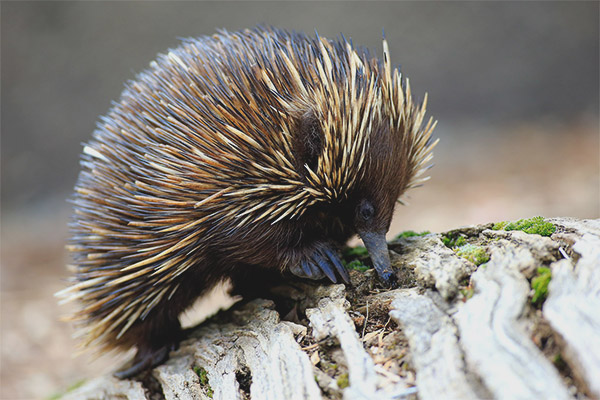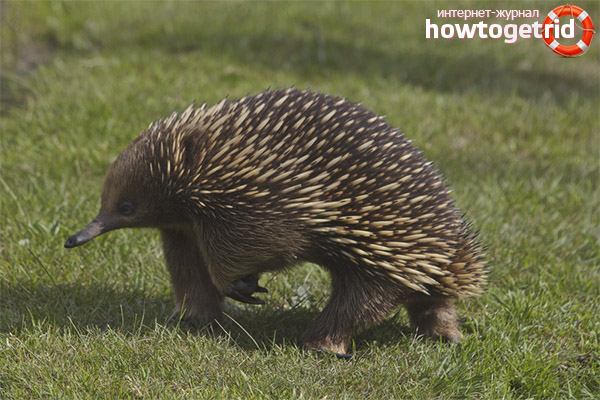The content of the article
Scientists had to organize a heated debate in their time in order to come to a common opinion as to which species and class to classify such an unusual animal as an echidna. The whole difficulty was that its appearance resembles a porcupine, because the whole body is covered with needles, and this animal belongs to the family of rodents. But she lays eggs to continue the race, and this is typical mainly for avian representatives. The offspring is in the bag. So this is a marsupial, resembling a possum or a kangaroo. In addition, the young feed on breast milk, and this is the privilege of a class of mammals, food is produced like an anteater. By the way, because of this quality has another name - the spiny anteater. Probably because in mythology there is Echidna - a woman with a beautiful face and a disgusting character, but the body of a snake is called a stoglav.
Nevertheless, scientists have determined the place of echidna in the classification of animals, including in the family of mammals, a detachment of monotremes.
Description of the species
The spiny anteater belongs to small animals, as it reaches a length of no more than 40 cm.
The head of the echidna is rather small. It smoothly grows together with the body. The long and elongated muzzle ends with a very small mouth, which is a kind of tube that looks like a beak.
Distinctive features are a rather long tongue and a complete absence of teeth. But they are not required, because the tongue is sticky, and only he helps the animal to eat. Licking off any surfaces of invertebrates that stick to a long tongue, the echidna can feed itself.
The limbs of the animal are rather short, but strongly developed, muscular. There are 5 fingers on them. They end in sharp, flat claws. Such claws help echidna dig the ground to get to the mound and destroy its walls. Termites - delicious food for echidna.
The echidna has a short tail, almost imperceptible. It is covered with a thick layer of fur and thorns and merges with the body.
The entire body of the animal from the sides to the back is covered with hollow, but very stiff needles. Their length is about 6 cm, and the color can be different and uneven - from white and yellow to brown, most often with black endings. This coating is modified hair, in which keratin plays the main role.
But the wool of this animal is also available. It is rough and very tough, and in the area of the ears is the thickest and longest. Its color can be either brown or black. The fur only partially covers the needles. Those individuals that live in colder areas where snow falls, have longer wool than needles.
Habitats
Echidna are the property of New Guinea. Mostly live in its south-eastern part. These animals also live in Australia.
First of all, habitats are forests and places with very densely populated vegetation. Only by sheltering in the foliage or in the roots of trees, can the echidna feel safe.But also the animal hides in small caves and rocky crevices, burrows, which had previously been dug by other small animals.
Lifestyle
In the daytime, when it is hot and there are many enemies around, the echidna prefers to be in her shelter, but when night comes, life-giving coolness comes, the animal goes on the hunt.
The echidna is not difficult to adapt to different conditions. If she lives in the desert, then in cool weather, she is active during the day.
If a danger suddenly appeared, a small brave animal could stand up for itself. In this case, his behavior is very unusual: he manages to quickly dig into the ground, of course. the soil is loose. Hiding almost half, he militantly demonstrates his sharp needles. It can also curl up into a ball, again, aiming the needles at the enemy, if the terrain was solid. However, in this case, the enemies of the animal, and this is primarily a fox, a dog dingo, a pig, attack in the unprotected part of the belly.
But, if the most dangerous threat to life appears, then it is not shameful to run away. Here the animal comes to the aid of his, though short, but powerful legs. They help to quickly rush to shelter and hide.The echidna is a good swimmer, and from danger it can also be saved in the water, overcoming considerable distances.
Individuals live separately, without having a permanent shelter, and their limited territory is constantly protected. However, neighboring farms can be imposed on each other, and very heated debates on this issue do not arise.
When the cold comes, the animal may fall into a little hibernation, although it was decided not to attribute the viper to the class of those animals that hibernate during the cold season. So nature takes care of the animal, because it does not have sweat glands, and to adapt to changing temperatures is therefore not easy. It is necessary to significantly change the temperature regime, as all activity disappears, the animal at this time is characterized by lethargy and lethargy. Falling into hibernation, the accumulated subcutaneous fat helps the animal to survive without food for about 4 months.
What eats?
Food of an animal does not differ in a special variety. They are mainly termites and ants, small worms and mollusks. To get to termites and ants, first have to work hard. For this, body parts are used.With its strong paws, the animal digs out an anthill or termitary full of tasty insects, and also removes bark from a tree or shifts stones on the ground. All actions are aimed at those areas where delicious insects are hiding. With the help of the nose, the animal explores the soil under the leaves and fallen broken branches.
Once the target is found, it's time to start sticky tongue. Having collected food on him, again with the help of the tongue, the prey is pressed against the sky and crushed. So the absence of teeth does not cause any difficulties.
Grinding occurs in the digestive tract, where various stones, sticks, grains of sand also fall. They also take part in crushing food.
Important periods
The mating season of echidna begins in winter. This Australian period lasts from May to September. Prior to this, the males living apart, unite, creating a group of about 6 individuals, together with them is one female. They live together for a month, feeding together. Then comes a kind of romantic period. He is notable for the fact that the males are caring for the lady. This is manifested in the following behavior: after the sniffing of each other, gentlemen begin to poke their noses into the region of the tail of the female.
When it's time for mating, the males surround the future mother, and the wedding dance begins, during which the grooms have time to make a rather large 25-centimeter trench near the female. It is necessary in order to determine the winner. A few minutes later the battle begins, during which everyone tries to push the enemy out of the line. The winner will deserve to continue the race.
Then, when needles appear, for the baby, the echidna finds a very secluded place and leaves him. Most often it is a place in the earth where the child is not in danger. He visits only once in 4–5 days to feed with milk, to teach many tricks that will help to find food and save life in the future. And so it goes on for 5-6 months.When this period ends, the grown-up strong child no longer needs care. Now he is quite ready for independence and will be able to protect himself.
The female, but not each, can produce offspring twice a year.
Life expectancy of this animal is up to 17 years. But there were cases when they lived much longer in zoos with good care.
Video: Australian echidna (Tachyglossus aculeatus)













To send